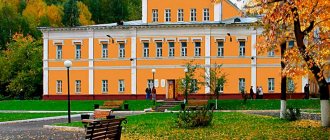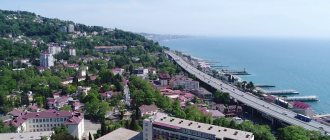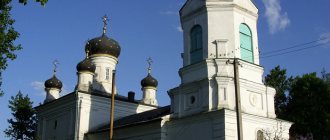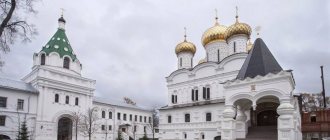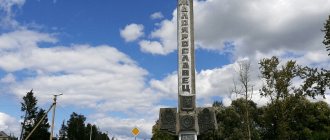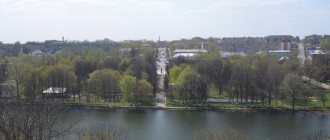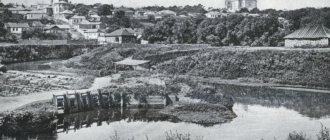On the banks of the Volga stands the city of Kimry, whose history began in the 16th century. For a long time it was considered the "shoe's edge." Cheap cattle were transported along the river past the town, which were bought for making shoes. During the reign of Peter I, the best shoemakers worked here. They made shoes for the Russian army. Thanks to the shoemaking industry, the city became rich, and the population began to lead a free lifestyle. It was at that moment that the phrase “drunk as a cobbler” appeared.
In 1915-1917 Kimry became a city. It had its own railway and a large shoe factory.
The name “Kimry” is an unusual word for Russian ears. The Chimera are ancient Celtic tribes. But they lived in the mountains of Wales and had never been to the Volga region. At the same time, there is a version that the Merya tribe lived on the site of the city of Kimry. These are Finno-Ugric tribes that came from the Trans-Urals and settled between the Oka and Volga rivers. And in the Celtic language, Merya and Cymry are the same word.
There are many interesting places around the city in the guide to the Tver region.
For ease of route planning, we have marked all the mentioned attractions on the city map:
Historical sites and museums
Kimry Local Lore Museum
Address: st. Kirova, 13/18 Phone: +7 (48236) 31267 Website: https://muzeykimry.ru Opening hours: 10:00 – 18:00 Wed-Sat, 10:00 – 17.00 Sun, Mon, Tue – closed Cost: students and pensioners – 50 rubles, adults – 100 rubles.
The museum has a permanent exhibition, which presents objects of everyday life and life of people since ancient times. The originals of the 16th-18th centuries are of particular value.
Visitors can see the restored interiors of a peasant's room, an Art Nouveau living room and interiors from the 30s to the 70s of the 20th century.
Since 2021, the museum has been running a multimedia exhibition “Capital of the Shoe Kingdom.” Visitors will interactively see the appearance of the streets, houses and life of the Kimryans of the 19th-20th centuries.
Kimry Drama Theater
Address: Teatralnaya Square, 2 Phone: +7 (48236) 31760 Website: teatr-kimry.ru Opening hours: 09:00 – 18:00 Mon-Fri Ticket prices: ground floor – 300 rubles, balcony – 370 rubles
The theater began its work in the summer of 1942. Throughout the war, the theater hosted 2-3 performances a day. In the morning, the theater troupe performed in hospitals, and in the evening ordinary residents came.
The theater actively developed when it was directed by A. M. Giatsintov. The troupe toured to Moscow and St. Petersburg, famous actors played in the performances, and after the war the theater received a certificate from I.V. Stalin.
But in the 70s, the theater was closed for reconstruction and opened on October 26, 1991.
Today, not only plays are staged in the theater. Before the performance, the audience will enjoy a performance by musician V.V. Borisov. New Year's performances for children are held annually, and the repertoire is supplemented by premieres.
District House of Crafts and Folklore
Address: st. Kirova, 19 Phone: +7 (48236) 31309 Website: https://kimrymaster.ru Opening hours: 09:00-17:00 Mon-Fri, 10.00-16.00 Sat, Sun Cost: 50 rubles
The craft school is located in an old building. Here in the 19th century lived the wealthy family of the peasant woman Shkvarina. She and her sons were engaged in trading and ran a farm. Since then, the house has remained unchanged and has not required major reconstruction.
The school began operating in 1995-97. It immediately began offering classes in hand embroidery, wood carving and leather working. All classes were aimed at students learning the folk crafts of the region.
The school has a folk costume laboratory. Traditional outfits that are used for performances by folk groups and performers are recreated here. At the museum, you can pre-book a group excursion, which will tell you the history of folk costume and conduct a master class on making a doll.
City of Kimry
The time has come for the last chapter about the reconstruction of Savelovo station.
From 2019 to this year, I watched how the station changed and how the work progressed. During this time I wrote a lot of posts, there was a lot of negativity and positivity, but where would we be without it? And so, in November 2021, the first stage of reconstruction of the Savelovo station was completed as part of the project for the development of the Dmitrov - Sonkovo - Mga line to increase capacity. Over these two years, the station has changed beyond recognition. To be honest, I lost all desire to film around the station, primarily because of the reactions of local residents who do not understand simple things, and on the other hand, the station became simply boring. But I thought that I needed to sum it up and shoot the last chapter.
On November 27, I took the morning electric train to Savelovo to assess the scale of the disaster.
The electric train to Savelovo is traditionally full, and as soon as you leave one stop from Degunino, the traffic of traders begins. Many noted that there are none within the boundaries of the MCD, but you will get on an electric train to Savelovo in the morning and you will be a little surprised. In the first 10 minutes, the entire assortment from Aliexpress went through, and then after that they carried all kinds of snacks - cauliflower, tomatoes and cucumbers. So it turns out that the electric trains are new, but the atmosphere is the same.
According to Catuar, I noticed a revival in the reconstruction of the platform - apparently they remembered what needed to be completed. And between Katuar and Trudovaya a merchant grandfather came in, I barely recognized him. He used to always sell vegetable peelers and was slightly positive, but now he has aged very much. He could barely stand with his cane, let his gray beard grow, but still fervently tried to talk about what he was selling. And then I caught myself thinking that time spares no one and how much I travel in this direction - I already know many of the sellers by sight. To be honest, I even felt a little uncomfortable with how quickly time was passing.
The Iksha turned out to be empty, then the green VL11 flew as a reserve along Trudovaya. I thought it was strange. Intelligence reported a powerful movement. But in Dmitrov everything fell into place: in the departure park we were stuck waiting for the green signals VL11 and VL10U with freight trains, but we were not sent because we were waiting for an oncoming train from Savelovo. In total, according to Dmitrov, there are three freight trucks at once. A separate report should have been made about the Dmitrov station a long time ago, because the Taldom neck of the station has already changed quite a lot. Beyond Dmitrov everything was as before, along Verbilki there was a traditional crossing with an electric train from Dubna, but we were already running late, as if a freight train was crawling ahead of us. At Taldom, this theory was confirmed; there, we were allowed ahead by the Oryol tee with a bulk train, already familiar to me from the last foray into Iksha.
Savelovo greets with gray and cool weather, an abundance of green electric locomotives that were ready to go with freight trains to Orekhovo and Bekasovo. Here I will add an abundance of noise barriers and ice. There was ice everywhere where people walked and the station workers simply hammered home the bolt. And we will begin examining the station, or rather what was done to it. Let's start point by point.
Since 2021, the following has been done at Savelovo station:
1. We increased the length of the receiving and departure tracks to 71 conditional cars, and completely laid a new track.
2. New lighting was installed - now the station looks like a Christmas tree at night. This is what most stations look like on the main OCT route between Moscow and St. Petersburg.
3. We built a normal turnaround point for electric trains from Moscow. Now there are 3 tracks and electric trains do not interfere with the high platform.
4. Manual arrows are a thing of history. Now the entire station is automated. To this we add a new electrical centralization post, which was opened quite recently. Now the duty officers are sitting there, and in the station building only the TsPPK ticket office and the local transport police department remain.
5. Conducted a major overhaul of the track from 129 km to 139 km.
In fact, the first stage of reconstruction is over, only a little remains. This is to complete several exhaust dead ends, organize the operation of the signaling system and switches, and complete the construction of a rest house for locomotive crews.
I decided to inspect the station in the Kalyazin neck of the station, although getting to it was a quest due to the abundance of ice on the platform and paths. There is a large crowd of local workers here, because sprinkling sand in the morning takes literally half an hour. As a result, while I was walking with breaks, I watched as older people, and even young people, dashingly fell on their fifth points, and some rolled towards the tracks. Sorry, this is a security breach. What if the train leaves? But the workers didn't care. I remember they reproached me that I always defend Russian Railways, but not always. This is a direct violation of the safety of passengers. At the local PTOL, a diesel locomotive of the 2TE116 series from the Ivanovo Northern Railway depot stood muttering in a hot state. Yes, I think many people can break the mold this way, but the Ivanovo depot has its own 2TE116, but it was unexpected to find such a machine in our area, but we’ll return to it later. The first thing that will catch the eye of any tourist, photographer or ordinary person is the new green fence around the perimeter of the station. Well, if it were an ordinary fence, it would also have barbed wire. You got the feeling that you were somewhere on the border, like Pytalovo or Ivangorod somewhere.
Here, a technical passage was made nearby for locals who need to cross the railway tracks to the other side, but it is impossible to walk along such a road, because it is all covered in ice. Questions again for the station workers. After all, carriages also walk on ice.
Now let's look at the station.
The entire station has shunting signals on, which is very unusual. For the adherents who call our road wooden, I send a big hello. In the Kalyazinskaya neck of the station, minor work was still going on - the noise barrier had not been fully installed, local workers were doing something at the switches.
What shines in between is not water, but ice. I heard a lot of flattering reviews from local residents about this. But as soon as I appeared with a camera, the local workers became a little embarrassed, and their leader quickly walked away towards the station. I thought that either my favorite police officer would come and present me for filming, or something else, but everything went quietly. And we take a look at Moscow, where a freight train has just arrived from Taldom.
The station was quite crowded with trains - 4/6 of the tracks were occupied. While standing and observing the life of the station, a diesel locomotive appeared from under a commuter train. He was performing maneuvers for a flight to Uglich. The locomotive number is already original.
I also photographed this diesel locomotive in blue, and then in green. Now he was caught in the third color option. Thanks to the included EC at the station, train turnover can occur faster. For example, instead of taking an hour and a half, freight trains now make a turnaround in 55 minutes, and maneuvers are even faster. But the schedules of passenger trains and commuter trains, alas, have not yet been touched.
So the M21 signal turned white. Photo for those who do not believe or will not believe that electrical centralization works in Savelovo.
A minute later, the diesel locomotive passed the M21 and proceeded under the commuter train to Uglich. And I took a walk towards Burkovo, where I found a cry from the locals.
Of course, they can also be understood. Any construction site causes discomfort, but most of the problems are still the responsibility of the local administration. For example, the same roads in villages should have been built by the authorities, not Russian Railways. The expansion of the Savelovsky direction has been known since 2014, and in just 7 years it is possible to build new roads. Same story with the move. In fact, Russian Railways, with its construction, opened an abscess that had been swelling for a long time in the city of Kimry, but local residents do not want to figure it out and blame others for everything, but not themselves, not the local administration. Construction will end, the builders will clean up after themselves wherever they can, and the roads in the villages will remain as they were 7-9 years ago. Well, as for the noise of trains, dangerous cargo, etc., I can only answer this way - you can write a letter to Russian Railways so that electric trains to Moscow are canceled and everyone will feel calmer, because electric trains also create noise.
Let's get back to the positive. Here at the station I finally met Sasha Konov, one of the members of our “Savelovskaya Magistral” community, we thought a little and decided to go towards Bely Gorodok, because there was nothing else to catch at the station. On the way, while we were walking to the station, I photographed a commuter train to Uglich.
I often come across expressions on all sorts of forums and chats, like people don’t come here and nothing new is needed here. But these people, living in Moscow, forget one thing. To bring back passengers, we need development and convenient train schedules. Now they are not particularly successful and the entire system of commuter trains from Savelovo to Pestovo needs to be updated and shaken up. Personal observation. On the Sonkovo-Savelovo train, 30 people arrived in two seated carriages. Saturday is not the peak day. About 25-30 people boarded the same two carriages at Uglich. I do not rule out that almost everyone goes to Kalyazin. During the season and peak days, these numbers can be safely multiplied by two, or even more. In the summer these are fishermen and summer residents. On Sundays and Fridays - students who live in Kashin and Kalyazin. More convenient communication has been needed here for a long time and preferably with acceleration, but for now, alas. Cities such as Kashin, Kalyazin and Uglich have great potential to become tourist destinations, which is now in fashion.
And we went to White Town, which will be a separate story. I also haven’t been to those parts for a very long time and it’s time to catch up. But we will return to Savelovo. Here, during our absence, there was a blockage at the station - there were no free tracks for receiving freight trains and there were no free diesel locomotive crews. Now this picture is more than real on our line. Due to the fact that there are more freight trains, there are traffic jams and delays at the station. On the day I was in Savelovo, about 10 pairs of freight trucks passed through the junction. In fact, this is the main problem of delays of electric trains from Savelovo and Dubna in the last month - the low capacity of the Moscow Railway from Savelovo to Dmitrov. I have written many times who is to blame for this and why, I will not describe it again. I’ll just say that this will happen for at least another 1.5 years, until 3 sidings are built on the Moscow Railway.
The main goal for which we returned to the station was the northern 2TE116, which was supposed to be driven under the train. In general, locomotives from the Northern Railway are no longer uncommon in Savelovo - 2TE116UD are the main locomotives on our route to Sonkovo, along with 2TE25KM. I still remember the moments when 2TE10V, 2TE10M/U from Ivanovo, Pechory came running here. But it was a long time ago. 2TE116 appeared in Ivanovo relatively recently and most machines work with PMS. Only 3-4 diesel locomotives out of 10 were seen in train work. This one wandered into our Savelovo, and since the bird is rare, it must be in the archives. We arrived on time, the diesel locomotive was just changing its cabin and maneuvering under the train.
I said that I filmed everything in Savelovo. As it turned out, there is more to come and sometimes there are interesting objects. On the second route, another 2TE116 was bored, waiting for the brigade. Quite suddenly, that day we saw as many as two old cars - now this is a rarity.
On this note, I said goodbye to Sasha and ran to the electric train to Moscow. It would be illogical to wait for the cargo to depart, since daylight hours are now short. By the way, as soon as they noticed me with the camera in the morning, by lunchtime the station was sprinkled with sand everywhere, which turned out funny.
For the first time at the Savelovo station I saw three diesel locomotives and only one electric locomotive. Usually, there has always been a shortage of OCT machines, but now it’s the other way around.
On the way, I came across 3 more freight trucks to Savelovo along Taldom, Verbilki and Dmitrov. Later it is learned that trains were also accumulated in Bely Gorodok, Sknyatino, and Kashin. I sense such movement - there was a small rehearsal of the new schedule.
Today, exhaust dead ends in Savelovo are being completed and, in general, traffic has calmed down a little. Previously, they wanted to increase the volume of traffic to a stable 8-10 pairs, which is almost equal to the traffic in Volokolamsk - there are stable 10-13 pairs.
Whether there will be a second stage of construction in Savelovo is unknown, as is the second stage of the entire project. Now almost all sidings have been completed (except for Dunevka and 50 km), and many have undergone major repairs of tracks and bridges.
The Savelovskaya Highway is now not the same road that was a protected wooden one. Now it is a small organism transporting freight in the direction of St. Petersburg. Thanks to this, Savelovo suddenly comes to life, the Khvoinaya station is being rebuilt and a new depot is being built there, which will most likely have its own assigned park. I will hope in my heart that this construction will give at least a small impetus to the development of passenger transportation, I know that there are not many people, but sections can and should be developed.
As for the Savelovo station, this was the last chapter with the construction of the station. I don’t see any point in writing or talking about anything anymore - almost everything is done. As part of our community and this blog, from time to time I will photograph the life of the station and its surroundings. I know that my blog is often googled for construction and other queries, I hope this post will be useful.
Source:
Savelovskaya Magistral
Parks and monuments, streets
Monument to the shoemaker
Address: st. Kirova, 18
The monument to the shoemaker was opened in September 2014 on the initiative of local residents. It was Kimry that was famous for its shoemakers since the 17th century.
To create the monument, a charitable foundation was opened under the leadership of A. Andreev and V. Sukovatitsyn. Over the course of 2.5 years, the fund collected the necessary funds from entrepreneurs, enterprises and donations from individuals.
Samvel Sardanyan, a member of the Union of Artists of Russia, worked on the creation of the monument.
It is believed that this is the only monument to a shoemaker in Russia.
Monument to the TU-124 aircraft
Address: street 50 let VLKSM
Kimry is the birthplace of A.N. Tupolev. He was an outstanding engineer in the field of aircraft construction. Thanks to him, more than 100 types of civil and military aircraft were developed. His inventions are a model of domestic aviation for many foreign engineering bureaus.
The TU-124 aircraft stands on the opposite bank of the Volga, not far from the aircraft plant. In 1984, it was donated by the design bureau of A. N. Tupolev to residents of the city of Kimry. The plane flew to the city on its own, and from the Borki airfield it was towed to the bridge over the Volga.
In the first years it was a popular monument among local residents. They took pictures here and held meetings. But in the 90s, the plane was damaged by vandals. The administration is currently working to restore the appearance of the aircraft.
Fadeev embankment
Fadeev Street is the oldest street in the city of Kimry. Before the revolution it was called Embankment. Since the 60s, it began to be called Fadeev Embankment in honor of the author of the book “Young Guard”.
It is better to start a walk along the embankment from the first building, which housed the Chaika Hotel. The house was built in the mid-19th century and belonged to the Chernigovsky family. They founded a hotel in their house and developed the fire service in the city. During Soviet times, the hotel became state-owned.
Previously, there was a wooden house behind the hotel. The merchant M.I. Ponomarev, the doctor I.I. Ponomarev and their sister O.I. Ponomareva lived in it. During the years of his life, the doctor Ivan Ivanovich Ponomarev cured many residents of the city of Kimry. He conducted his medical practice only at home and did not leave it. But the family faced a sad ending. None of them had children, so with the death of their brothers and sister, the clan ceased to exist. The house was dismantled in the late 70s of the last century.
House No. 4 belonged to wealthy merchants Shkvarins. The brothers owned a steamship with barges and traded on it along the Volga. The house had a platform from which the brothers could watch musicians’ concerts on the embankment. But with the advent of Soviet power, the brothers’ trade stopped, a hospital was set up in the house, and then a police detachment.
In house No. 6, the merchant Rybkin lived on the first floor, and the second floor was rented by an agent of a shipping company. The famous writer Saltykov-Shchedrin visited the hosts. But there is no reliable information about his residence in the city of Kimry.
House 39 has been preserved, which is now on the corner with Lenin Street. It belonged to tanner V. M. Kryukov. Under Soviet rule, communal apartments were built in the house.
In house No. 11, the Falchevsky family lived on the first floor, and actress A. M. Zaitseva lived on the second floor.
Historical buildings after crossing the embankment with Radishchev Street have not been preserved.
General information
Currently, there are several dozen large and small enterprises in Kimry. Among them, the Savelovsky Machine Tool Plant stands out - a large enterprise producing high-tech and knowledge-intensive machine tools. There are enterprises in metalworking, woodworking, high-tech instrument making, clothing and footwear industries.
In 2013, a project was launched in the Tver region - “Preservation and use of cultural heritage in Russia”. As part of this project, they decided to implement the “Capital of the Shoe Kingdom” program in Kimry. A festival of historical reconstruction is held annually in Kimry
"Epic Coast". The purpose of the festival is to highlight the culture and traditions of the ancient Russian state and reproduce various historical events.
The name of the ancient city of Kimry is on everyone’s lips. The city has a glorious historical past and a large number of architectural and historical monuments. But in general, the city still has the fate of most small provincial ancient towns. It’s not enough to just talk about “grey-haired antiquity” - you need to invest money to preserve it and do it systematically, from year to year. Alas, the city authorities have not succeeded in this yet. Many unique ancient objects are in deplorable condition. But Kimry can become such a finger-licking tourist candy!
Churches and Temples
Temple of the Ascension
Address: Kalyaevsky lane, 2 Phone: +7 (48236) 31753 Website: vozneseniekimry.ru Opening hours: 09:00-14:00 Mon-Thu, 09:00-19:00 Fri-Sun, 14:00 - 16:00 break
The bell tower of the temple is visible from almost anywhere in the city. It was built in 1813 to replace two burnt wooden churches. Since then, it has undergone alterations, but has retained its general appearance.
The temple was erected at the expense of parishioners and merchants the Bashilovs. Thanks to the merchants, the refectory in the temple was later expanded, decorations were added, an iconostasis was installed, and the bell tower was reconstructed. After their death, the brothers bequeathed funds for the maintenance of the temple.
For a long time, a document from the 17th century was kept in the temple. It was signed by Tsars Ivan and Peter and issued to the boyar Saltykov. But at the beginning of this century the letter was transferred to the Tver museums.
In addition to the diploma, the church kept a silver cross of Countess Samoilova, an icon of Dmitry of Solon, an image of the Savior and the Sign of the Mother of God.
During the Soviet government, the temple was seized and used as a warehouse for Kimrotorg. The status of the temple was returned only in the early 90s.
Transfiguration Cathedral
Address: st. Uritskogo, 65 Phone: +7 (48236) 31970 Website: kimry-sobor.ru Opening hours: 08:00-12:00 Mon-Fri, 07:30-19:00 Sat-Sun
Construction of the temple began in 1902 and was completed in 1911. During this period, they did not have time to build the stone bell tower, and after the revolution, the Soviet authorities forbade its completion. In 1927, a document was signed on the closure of the temple. But on the first attempt, the authorities failed to describe the property. On the day of closure, parishioners surrounded the church and did not let officials in. They turned to the police for help. After the arrest of the instigators, the temple was described and closed.
At first, the building was used to house artisans, but then they began to store grain there.
During the Great Patriotic War, the church made a tangible contribution to the victory, which allowed parishioners to visit it after the victory over the Nazis.
How Kimry became the capital of the shoe kingdom, and what remains of its former luxury today
Nowadays, Kimry makes a very depressing impression on the traveler. You can’t look at once beautiful buildings that are falling apart before your eyes without tears. When asked why this is happening, local authorities just shrug their shoulders: there is no money. Yes, when local budgets do not have enough funds to pay salaries to state employees, the necessary repairs of city infrastructure and maintenance of the social sphere, there is no time for restoration of ancient buildings, enough for people.
Mansion of the merchant Teplov (Kirova St., 5)
Kimry, which stands on the high Volga bank at the confluence of the Kimrka River with the Volga, was called Kimra in the old days. The Kimrka River divided the settlement into two parts: the central Trinity and the trans-river Voznesenskaya. Before the revolution, it was one of the richest villages in Russia, its appearance more reminiscent of a city, a major center of the leather and footwear industry.
The confluence of the Kimrka and the Volga and a view of the Voznesenskaya side
The first people appeared in these places about 12 thousand years ago. In the 10th-11th centuries, the Krivichi came here, who may have assimilated the Merians living here. In 1485, these lands, as part of the Grand Duchy of Tver, were annexed to the Moscow Principality.
The village of Kimra was first mentioned in the letter of Ivan the Terrible dated February 15, 1546. At that time it was under the jurisdiction of the order of the Grand Palace, i.e. was a palace official and complained to particularly distinguished civil servants. The owners of the village in the 16th-18th centuries were Staritsky Prince Vladimir Andreevich, Prince Fyodor Ivanovich Mstislavsky, Prince Alexey Mikhailovich Lvov, boyar Alexander Petrovich Saltykov, Countess Ekaterina Ivanovna Golovkina (nee Princess Romodanovskaya), Countess Anna Karlovna Vorontsova (nee Countess Skavronskaya).
Thanks to its advantageous position on the Volga, Kimry grew quickly. Even during the time of Ivan the Terrible, “not only from Pereslavl, but even from Smolensk,” peasants from the Pesnoshsky, Solovetsky, and Belozersky monasteries, came to trade in Kimry. By 1635, there were 104 households in Kimra.
Volga in Kimry. The bridge across the Volga was built in 1974-1978, its length is 905 m, width - 20 m, height - 15 m
Kimry and the surrounding area have long been famous for their tanning industry. At the beginning of the 18th century, Vasily Fedorovich Saltykov, who owned the village at that time, achieved the placement of part of the army orders in Kimry: Kimry peasants supplied shoes, leather uniforms and saddles for the needs of the army. The Kimryaks improved the boot: they put it on a hard sole and strengthened the back. Thanks to this order, the shoemaking industry in Kimry began to develop rapidly. According to the Swedish traveler Strolenberg, who visited these places in 1710, “In Kimry there are the best tailors and shoemakers, known throughout Russia.”
In the second half of the 18th century, Kimry became one of the largest centers of the Russian shoe industry. It was not without reason that they said that “the Russian army marched along the pavements of Paris in boots made in Kimry.” As a sign of gratitude for the supply of shoes to the army in 1812, Emperor Alexander I granted the village a battery of cannons, which were subsequently fired on holidays.
A.K. Vorontsova’s husband, Count Mikhail Illarionovich Vorontsov, played a major role in the development of the village. Thanks to him, trade began to actively develop in Kimry; stone shopping arcades were built on Cathedral Square. At the beginning of the 19th century, the Kimryaks also began to engage in the grain trade along the Volga and, having become rich from this, began to invest money in the shoemaking craft, thereby contributing to its further development.
In 1847, Countess Yulia Pavlovna Samoilova, the last owner of the village, who mostly lived abroad, sold the Kimry estate to the treasury. The Kimry peasants, together with the surrounding villages, took advantage of the situation and bought themselves with land and buildings for 495 thousand rubles (a considerable amount at that time) with an installment plan of 37 years and 6% per annum.
Kimri shoemakers and shoemakers were divided into two categories. The first category included the owners of large workshops. The second category consisted of village residents who sewed shoes at home and sold them at Saturday markets. A real “shoe kingdom” with an area of 1,500 square kilometers has formed around Kimry. In the 18th century, the shoe industry actively developed in Taldom, located not far from Kimry.
Illustrated map of European Russia, 1896. Kimry is marked with a cross. Source: retromap.ru
Shoes made by the Stolyarovs were very popular. The boots they made were highly praised at the World Exhibition in London in 1862. The issued diploma gave them the right to put a personal brand on the inside of the boot. In 1907, the Partnership of N.A. Stolyarov and his sons founded the Yakor shoe factory. In 1916, 200 thousand pairs of shoes were produced here.
Before the First World War, there were more than 16 thousand shoemakers in Kimry district and the adjacent volosts of Kashinsky and Kalyazinsky districts. The volume of products produced was amazing: about 2.5 million pairs of shoes per year! They said: “Kimryak makes boots from clay.” A unique collection of Kimry shoes from the 18th-19th centuries can be seen in the local local history museum.
Shoemaker at work. Exposition of the Kimry Museum of Local Lore. Photo from the museum website muzeykimry.ru
Kimry fairs were one of the largest in the Tver province. Up to 20 thousand people attended them every week. Of course, the most popular product was shoes. Usually it was sold in bulk to buyers - “burbots”, as they were called, who then resold it at a much higher price throughout Russia.
Market day, 1917-1930. Source: pastvu.com
Kimry owes its urban appearance to the great fire of 1859, in which almost all of the wooden buildings were destroyed. Emperor Alexander II ordered the allocation of 18 thousand rubles without repayment and a loan of 14 thousand for the restoration of the village. Insurance premiums amounted to 27 thousand rubles. Kimry received a regular development plan, although this was the privilege of the cities. However, the Kimryaks were in no hurry to change their status to urban ones, so as not to pay higher taxes compared to rural ones.
Panorama of the village of Kimry from the bell tower of the Trinity Cathedral, 1913-1917. Source: pastvu.com
View from the bell tower of Trinity Church, 1900-1903. Source: pastvu.com
View from the bell tower of the Trinity Church on the Kimrka River, 1915-1938. Source: pastvu.com
Where the red and white building of the Kimry Ladies and Comedy Theater is now located, there used to be a cold, five-domed Intercession Cathedral. It was erected in 1816-1825 on the site of the baroque church of the same name, built by Italian architects, which burned down in a fire in 1807. Closer to the Kimrka River stood the winter single-domed Trinity Cathedral with a bell tower, built in 1829-1833. According to the authors of the publication “European Russia” in 1913, the Great Cathedral Square in Kimry could be an adornment of any provincial city, and even the capital.
Temple complex. Cathedral of the Intercession of the Blessed Virgin Mary and the Cathedral of the Life-Giving Trinity, 1903. Source: pastvu.com
Trinity and Intercession Cathedral, view from the Volga, 1867. Source: pastvu.com
The Intercession Cathedral was closed in 1930 and blown up in 1936. In its place, the Industrial Cooperation Club was erected, and in the 1980s, the current building of the Drama and Comedy Theater was erected. After its closure, Trinity Cathedral was used as a granary; in 1936 it was planned to be rebuilt as a museum, but in 1937 it was dismantled into bricks. Now in its place there are private residential buildings.
The Kimry Drama and Comedy Theater was formed in 1942 as a result of the merger of the evacuated Rzhev and Torzhok theaters
On the Ascension side there is the Church of the Ascension of the Lord. It was built in 1813 at the expense of parishioners and the Bashilov brothers, on the site of a wooden church that had previously stood here. It was closed in 1941, after which it housed an oil mill, then the warehouses of the Kimry Trading Society. In 1990, it was handed over to believers, and restoration began.
Church of the Ascension of the Lord and the Ascension part of Kimry
Three cathedrals created a beautiful perspective, marking the mouth of the Kimrka.
View from the bell tower of the Ascension Church on the city of Kimry. 1903 Photo by M. P. Dmitriev. Source: pastvu.com
In 1902, construction of the Transfiguration Cathedral began in Kimry, which was completed in 1911. It was closed in 1929, and the priests who served there were shot. The building of the former temple housed a handicraftsmen's club, then a granary. However, in 1947, at the request of believers, services there were resumed.
Transfiguration Cathedral in Kimry (Uritsky St., 65). Source: Wikipedia
In total, before the revolution, there were six Orthodox churches in Kimry, as well as the courtyard of the Ilinsky Holy Trinity Convent. Only two of them have survived to this day: the Transfiguration Cathedral and the Church of the Ascension of the Lord. The courtyard building has now been rebuilt and houses various institutions and shops.
On October 12, 1912, on Cathedral Square (now Teatralnaya Square), approximately where the flowerbed is now laid out, a monument to Emperor Alexander II was erected: Grand Duke Alexander Nikolaevich, the future Emperor Alexander II, visited Kimru in 1837.
Monument to Tsar the Liberator Alexander II, 1912. Source: pastvu.com
In 1914, on Cathedral Square, on the site of the dilapidated Vorontsov Gostiny Dvor, the New Gostiny Dvor was erected in a neo-Russian style, reminiscent of Moscow's Upper Trading Rows (GUM) in miniature. A little earlier, in 1909, brick shopping arcades were built on the site of the old shops.
New Gostiny Dvor and Trading Rows on Cathedral Square, 1914-1917. Source: pastvu.com
Alas, today all that remains of Gostiny Dvor and Trading Rows are ruins.
Ruins of Gostiny Dvor (before the collapse)
Ruins of Gostiny Dvor and Trading Rows (photo taken in 2014, before the collapse)
In 1890, the population of Kimry exceeded 6 thousand people, in 1916 - 20 thousand. The rich Kimryaks invited famous architects and built houses “like in the capitals.” Unlike the very poor peasants of the Tver province, they were wealthy people, dandies and generally lived in grand style. Perhaps this is where the famous saying comes from: “Drunk as a cobbler.”
Bolshaya Street (now Volodarsky Street), 1890-1908. Source: pastvu.com
Ilyinskaya Street (now Uritsky Street) near the houses of Naumov (No. 6) and Sobtsov (No. 5), 1914-1917. Source: pastvu.com
Troitskaya Street, 1890-1907. Source: pastvu.com
In March 1871, the Kimry Rural Public and Moshkin Brothers Bank was established in Kimry, which became the first rural bank in the Russian Empire. By 1916, two banks, a treasury, and a credit partnership operated in Kimry; there were 4 schools, 2 ministerial schools, 5 zemstvo schools; there were almshouses, a fire station, a power plant, a water supply system, a library-reading room, shelters, and a post office.
Kimry Trinity Temperance Society. Tea room. Corner of Konnaya and Ilyinskaya streets. 1906-1911. Source: pastvu.com
In 1900-1902, the Savelovskaya railway was built, connecting Moscow with the village of Savelovo located on the opposite bank of the Volga (now part of the city of Kimry). In 1915, railway workshops for the repair of rolling stock of narrow-gauge railways were opened in Savelovo.
Savelovo station, 1910-1917. The water tower was demolished in the 2000s, allegedly due to a crack in the brickwork, and the station building is upholstered in siding in the gray and red colors of Russian Railways. Source: pastvu.com
During the First World War, large manufacturers organized the Military-Industrial Committee in Kimry, which supplied shoes to the front. The city also organized a Committee for the construction of hospitals named after traders and industrialists of the village of Kimry, which was headed by Vasily Nikolaevich Serepyev, who provided his home for the hospital of the All-Russian Zemstvo Union.
Hospital of the All-Russian Zemstvo Union, 1915. Source: pastvu.com
On June 3 (16), 1917, the village of Kimry received the status of a city by decree of the Provisional Government.
During the Civil War, the Yakor factory continued to produce shoes, mainly of army type. During this time, 300 thousand pairs of shoes were manufactured. In 1923, for services to the Red Army, it was renamed “Red Star”. During the Great Patriotic War, Red Star produced 3 million pairs of shoes, including 1 million soldiers’ shoes. The famous tarpaulin boots were made, among other things, in Kimry.
The Soviet writer A.A. Fadeev was born in Kimry, the village of Pustomazovo near Kimry is the birthplace of aircraft designer A.N. Tupolev. The Kimrys also became famous for their original artists. Self-taught sculptor I.M. Abalyaev (1901-1941) created naive sculptures of small forms, many of which depict Kimry artisans. The works of the representative of naive art, Baba Lyuba - Lyubov Mikhailovna Maykova (1899-1998), fascinate with their images and colors. Their works can be seen in the Kimry Museum of Local Lore.
Currently, Kimry is a regional center in the Tver region with a population of less than 45 thousand inhabitants. The remains of the former luxury of the once richest village can be seen today.
Houses on Volodarskogo Street
The building of the Public Bank (1912) and the main house of the city estate, 2nd floor. XIX century - Sobtsova gymnasium (Volodarsky St., 24, 26)
House in Art Nouveau style (now a post office, Volodarskogo St., 18)
The former merchant club of A.N. Naumov (4/6 Uritskogo St.) and a house built in 1913 (6/4 Mayskaya Square)
Houses on Kirova Street
Of course, it’s worth going to Kimry: the architecture of Kimry is an excellent example of provincial modernism. We must hurry to see what has not yet been destroyed by time and people.
House of the Luzhin brothers (photo from 2014, before restoration; Kirova St., 28a-b)
House of Doctor N.A. Zhardetsky (Kirova St., 3)
House of the Serepyevy merchants (Kirova St., 23)
But it’s just very sad that what was once the richest village has turned into a city whose name is associated more with devastation, drugs and crime. But this is a problem for our entire country...
© Website “On the Roads of the Middle Way”, 2009-2021. Copying and reprinting of any materials and photographs from the site anashina.com in electronic publications and printed publications is prohibited.
Attractions in the surrounding area
Zoocircus Kolkunovo
Address: Kimry district, Pleshkovo village Telephone: +7 (495) 7369486; +7 (916) 7369449 Website: kolkunovo.ru Opening hours: around the clock How to get there: from the city of Kimry, move 17 km towards the village of Pleshkovo. The complex is located at the exit of the village.
On the territory of the Kolkunovo complex there is a petting zoo with horses, ponies and other animals.
Adults can enjoy water sports, visit the sauna, and go fishing.
There are several houses available for accommodation with a capacity ranging from 2 people to 10.
UFO Park
Address: Pleshkovo village, Leninsky pr., 72/2 Telephone: +7 (495) 7369486 hours: 24 hours Cost: 550 rubles – complex ticket; 250 rubles – for children over 3 years old How to get there: from the city of Kimry, move 13 km towards the village of Pleshkovo
A large amusement park opened in the suburbs of Kimry in 2014. The territory has a variety of children's attractions, playgrounds, a rope park for adults and children, a swimming pool, and a zoo.
The zoo features domestic and exotic animals. The park occupies a large area, so many animals live in the forest in comfortable conditions.
The park is located on the shore of a pond where you can go fishing or swim on a catamaran.
You can relax after a walk in small cafes, which are evenly distributed throughout the complex.
Museum of reptiles
Address: Volzhsky village, st. Vostochnaya, 4A Phone: +7 (48236) 79348 Website: muzey.gadovo.ru Opening hours: 08:00-16:00 Tue-Fri, 11:00-16:00 Sat, Sun, Mon - closed How to get there : drive 30 km from the city of Kimry along the Kimry – Bely Gorodok highway
Volzhsky was formerly called Gadovo. According to one legend, this village is the birthplace of the fairy tale hero Zmey Gorynych. According to another version, there were always a large number of snakes in this village. But due to the dissonant name, in the 60s Gadovo was renamed Volzhsky.
Now the museum exhibits snakes made from a variety of materials. It is best to visit it with children. Various events are organized for them, they are told about the history of the region, about snakes and how to behave.
There is a Russian-style cafe in the museum building.
Church of Our Lady of Jerusalem
Address: Bely Gorodok village Phone: +7 (48236) 3-92-98 Website: hram-belogorodok.ru How to get there: follow the Kimry – Bely Gorodok highway 20 km
The history of the church is closely connected with the icon of the Mother of God of Jerusalem. According to legend, the miraculous icon was painted by the Evangelist Luke. The icon was kept near the right choir.
After the revolution, the temple was closed. In the 90s, a religious community was formed, which achieved the opening of the temple and the restoration of the church.
If you have not yet chosen where you will live and want to save money when booking, we recommend using the RoomGuru service. Firstly, it contains hotels, apartments and guest houses from many different booking systems, so you won’t miss out on a worthwhile option. Secondly, you can immediately compare prices for one place in different services and book where it is cheaper (this is not always Booking!).
